
By: Nick Knotts, Industrial Engineer, The Lawton Standard Company
Why stainless steel?
When it comes to castings for heat resistant applications, stainless steel is one of the most commonly selected materials. Heat resistant steels are made up of a variety of different microstructures, ranging from ferritic to austenitic and everything in between. Heat resistant steels also display a wide variety of mechanical properties, ranging from an Ultimate Tensile Strength (UTS) as high as 107ksi down to 65ksi at room temperature and a Yield Strength (YS) of 81ksi to 36ksi at room temperature.
How to measure performance
However, the key component of a heat resistant steel is its durability at high temperatures, which can be measured in a variety of different ways. One way to measure the performance of a steel at high temperatures is to measure the UTS and the YS at elevated temperatures, typically more than 1200F. Many heat resistant steels can hold a UTS of 30-50ksi at 1400F and a YS of up to 30ksi. Typically, alloys that have a sufficiently high chromium and nickel content perform the best in this category of elevated temperature tensile and yield strength, including HL, HP, HU, and HK. Alloys in this category typically have a fully austenitic structure. Due to the higher presence of alloying elements, these alloys also tend to be more expensive.
Another way that performance of heat resistant steel is measured is in terms of its creep and stress rupture strength. Creep is extremely common in heat resistant steel castings. For those who are unfamiliar, creep is the stress that occurs to castings that are under strain at high temperatures. While entirely preventing creep is not possible, most heat resistant steel alloys are designed to minimize the effect of creep to some degree, which in turn, prolongs the service life of the casting. Where creep becomes the most problematic is in select cases where it leads to casting deformation and can even lead to fractures due to the strength of the casting being compromised such that it fractures below the properties defined in an elevated temperature tensile test.
Alloy selection
Creep can be accounted for in casting design and in alloy selection, an engineer can select a casting design that will allow the casting to continue to perform for an extended period in the event of creep and may also select an alloy that is more resistant to creep. In terms of alloy selection, an engineer should select an alloy that slows the process of plastic deformation and has a high rupture stress, prioritizing one or the other based upon the application. In terms of deformation control, the best bet is typically to go with an alloy that contains at least 30% nickel and 15% chrome to obtain a fully austenitic structure, HT, HU, and HP are great examples. Some iron-chromium-nickel alloys such as HK also perform well in this arena.
When it comes to the rupture stress, controlling carbon content to be in the 0.3-0.7% range will be the most important variable. In the 0.3-0.7% carbon range, the metal will be much more resistant to rupture stresses than those that are 0.2% and below. Other alloying elements are also key, particularly enough nickel to form an austenitic structure (At least 18%, preferably 22%+) and a chromium content more than 15% are key, HK, HN, and HP are quality examples. Some of the most rupture resistant alloys will contain some content of specialized alloying elements such as tungsten or niobium, though carbon content remains the most impactful variable to control.
Avoiding oxidation
Another key in stainless steel is resistance to oxidation at high temperatures. For this reason, a heat resistant stainless steel must contain a minimum of 12% chromium to resist iron oxide formation at high temperatures. Further oxidation resistance can be obtained through a higher chromium and nickel content.
Thermal fatigue
If a casting is subjected to thermal cycling or shock, that must also be taken into account when it comes to alloy selection for a heat resistant steel. There is not a great way to measure thermal fatigue in a casting, there are thermal fatigue tests, but they do not greatly carry over to reality.
How to resist carburization
Carburization resistance is another consideration to be made, especially for castings that will be involved in an application like commercial heat treatment. Higher nickel and chromium contents largely increase the resistance of the metal to carbon penetration into the surface of the casting. Silicon plays a vital role in carburization resistance as well, small increases in silicon can make a drastic difference on the ability of the alloy to resist carbon penetration, typically around 2% silicon is used in castings that are meant to resist carburization. Other alloying elements have been added to stainless steels to resist carburization though are not widely used and their effectiveness remains debatable.
Other considerations
In rare cases, considerations need to be made for a high sulfur environment that will cause oxidation in the steel castings. High nickel content heat resistant alloys are very prone to corrosion in a high sulfur environment due to their fully austenitic structure, so alloys that are entirely ferritic are typically a better selection.
Contact us!
Have any questions about stainless steel? Need heat resistant castings? Reach out to a foundry expert today!